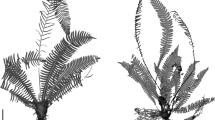Abstract
Wild edible mushrooms consumed by the ethnic tribes of India were collected from the local markets and forests and identified based on their morphology. The edible fungi collected were affiliated to 10 different species under 9 genera and 8 families. The fruiting bodies of the 10 wild edible mushroom species generated unique colour change profiles upon reaction with 3 % aqueous solution of phenol, 10 % solution of potassium hydroxide and 10 % solution of ferrous sulphate. A detailed study on the spore morphology of the specimens was carried out using staining techniques and Scanning Electron Microscopy. The complementary use of Scanning electron microscope (SEM) with an optical microscope offered characteristic features on spore morphology with SEM providing a three-dimensional micro-architecture of the mushroom spores. The present study will, therefore, serve as a taxonomic reference point for further studies on wild edible mushrooms of the region.

Similar content being viewed by others
References
Wong JLG, Thornber K, Baker N (2001) Resource assessment of non-wood forest products- Experience and biometric principles. Non-wood forest products, 13 FAO, Rome
Baruah HK, Sing DK, Islam M (1971) On the distribution of higher Basidiomycetes in the Sibsagar district. Assam. Bull Bot Surv India 13(3 & 4):285–289
Sing NI, Sing SM (1993) Edible fleshy fungal flora of Manipur. Bioveel 4(2):153–158
Sing NI, Sing SM, Th C (2002) Fleshy Fungi of Manipur. In: Vij SP, Kondo K, Sharma ML, Gupta A (eds) Plant genetic diversity–exploration, evaluation, Conservation. Affiliated East West Press Pvt. Ltd., New Delhi, pp 9–13
Harsh NSK, Joshi K (2008) Mushrooms: The vegetable of future. In: India, Science and Technology. http://ssrn.com/abstract=1474175
Sarma TC, Sarma I, Patiri BN (2010) Wild edible mushroom used by some ethnic tribes of western Assam. Bioscan 3:613–625
Barua P, Adhikary RK, Kalita P, Bordoloi D, Gogol P, Singh RS, Ghosh AC (1998) Wild edible mushrooms of Meghalaya. Ancient Sci Life 3(17):190–193
Agrahar-Murugkar D, Subbulakshmi G (2005) Nutritional value of edible wild mushrooms collected from the Khasi hills of Meghalaya. Food Chem 89:599–603
Hyde KD (2003) Mycology and its future in the Asia region. Fungal Divers 13:59–68
Das K, Sharma JR (2002) The genus Lactarius in India. Bull Bot Surv India 44 (in press)
Khaund P, Joshi SR (2013) Wild edible macrofungal species consumed by the Khasi tribe of Meghalaya. India. Indian J Nat Prod Resour 4(2):197–204
Largent D (1977) How to Identify Mushrooms to Genus I: Macroscopic Features. Mad River Press Inc., Eureka
Kuo M (2006) Making spore prints. http://www.mushroomexpert.com/spore_print.html
Brundrett M, Bougher N, Dell B, Grove T and Malajczuk N (1996) Working with Mycorrhizas in Forestry and Agriculture. AClAR Monograph. 32. 374 + x p
Kuo, M. (2006, November). Testing chemical reactions. Retrieved from the MushroomExpert.Com Web site: http://www.mushroomexpert.com/macrochemicals.htm
Donk MA (1961) Four new families of Hymenomycetes. Persoonia 1:405–407
Donk MA (1964) A conspectus of the families of Aphyllophorales. Persoonia 3:199–324
Villegas M, Cifuentes J, Torres AE (2005) Sporal characters in Gomphales and their significance for phylogenetics. Fungal Divers 18:157–175
Maneevun A, Dodgson J, Sanoamuang N (2012) Phaeoclavulina and Ramaria (Gomphaceae, Gomphales) from Nam Nao National Park. Thailand Trop Nat Hist 12(2):147–164
Petersen JH (1999) Key to the genera of clavarioid fungi in Northern Europe. http://www.mycokey.com/MycokeyDK/DKkeysPDFs/ClavarioidGenusKey.pdf
Thacker JR, Henkel TW (2004) New species of Clavulina from Guyana. Mycologia 96(3):650–657
Škubla P (2006) Lactarius hrdovensis, novy druh sekcie Uvidi zo Slovenska. Czech Mycol 58(1–2):67–73
Buyck B, Hofstetter V, Eberhardt U, Verbeken A, Kauff F (2008) Walking the thin line between Russula and Lactarius: the dilemma of Russula subsect. Ochricompactae Fungal Divers 28:15–40
Das K, Verbeken A (2012) New Species of Lactarius subg. plinthogalus and New Records of Lactifluus subg. gerardii (Russulaceae) from Sikkim, India. Taiwania 57(1):37–48
Kuo M (2011) “Cantharellus cibarius”: The chanterelle. http://www.mushroomexpert.com/cantharellus_cibarius.html
Arora D (1986) Mushrooms demystified. Ten Speed Press, Berkeley
Zheng HD, Liu PG (2008) Additions to our knowledge of the genus Albatrellus (Basidiomycota) in China. Fungal Divers 32:157–170
Vellinga EC (1986) Some species of Laccaria from India. Sydowia 39:224–229
Matheny PB, Aime MC, Smith ME, Henkel TW (2012) New species and reports of Inocybe (Agaricales) from Guyana. Kurtziana 37(1):23–39
Stalpers AJ, van Zaayen A (1981) Scanning Electron Microscopy of basidiospores of Agaricus bitorquis and of healthy and virus-infected Agaricus bisporus. Mushroom Science XI, Proceedings of the Eleventh International Scientific Congress on the Cultivation of Edible Fungi, Australia, pp 449-454
Tsujikawa K, Kanamori T, Iwata Y, Ohmae Y, Sugita R, Inoue H, Kishi T (2003) Morphological and chemical analysis of magic mushrooms in Japan. Forensic Sci Int 138:85–90
Co-David D, Langeveld D, Noordeloos ME (2009) Molecular phylogeny and spore evolution of Entolomataceae. Persoonia 23:147–176
Acknowledgments
Authors acknowledge the financial support received from Department of Science and Technology (DST), Government of India. Scanning Electron Microscopy facilities availed from Sophisticated Analytical Instrument Facility (SAIF), North- Eastern Hill University is duly acknowledged.
Author information
Authors and Affiliations
Corresponding author
Electronic supplementary material
Below is the link to the electronic supplementary material.

40009_2014_272_MOESM1_ESM.jpg
Fig. 1a–j: Spore prints of the mushrooms PKSR1(1a), PKSR3(1b), PKSR5(1c), PKSR7(1d), PKSR8(1e), PKSR10(1f), PKSR11(1 g), PKSR12(1 h), PKSR13(1i), PKSR1CF(1j).; Fig. 2a–j: Lactophenol Cotton Blue staining of spores of mushrooms PKSR1(2a), PKSR3(2b), PKSR5(2c), PKSR7(2d), PKSR8(2e), PKSR10(2f), PKSR11(2 g), PKSR12(2 h), PKSR13(2i), PKSR1CF(2j); Fig. 3a–j: Melzer’s reagent staining of the mushrooms PKSR1(3a), PKSR3(3b), PKSR5(3c), PKSR7(3d), PKSR8(3e), PKSR10(3f), PKSR11(3 g), PKSR12(3 h), PKSR13(3i), PKSR1CF(3j)
Rights and permissions
About this article
Cite this article
Khaund, P., Joshi, S.R. Micromorphological Characterization of Wild Edible Mushroom Spores Using Scanning Electron Microscopy. Natl. Acad. Sci. Lett. 37, 521–527 (2014). https://doi.org/10.1007/s40009-014-0272-1
Received:
Revised:
Accepted:
Published:
Issue Date:
DOI: https://doi.org/10.1007/s40009-014-0272-1




